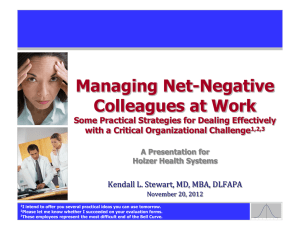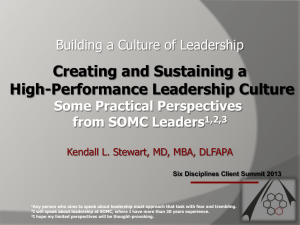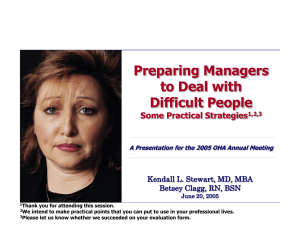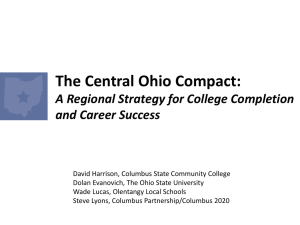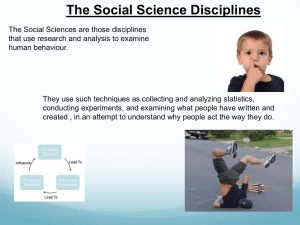Managing Net-Negative People - Southern Ohio Medical Center
advertisement
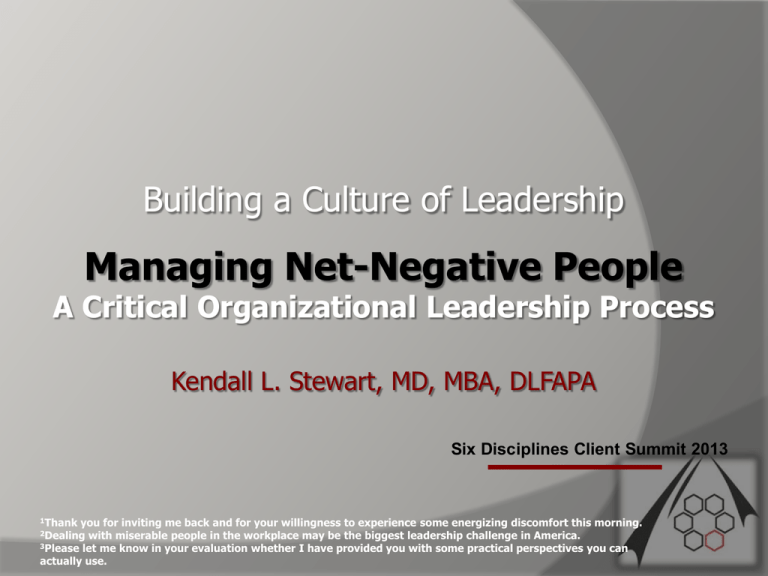
Building a Culture of Leadership Managing Net-Negative People A Critical Organizational Leadership Process Kendall L. Stewart, MD, MBA, DLFAPA Six Disciplines Client Summit 2013 1Thank you for inviting me back and for your willingness to experience some energizing discomfort this morning. with miserable people in the workplace may be the biggest leadership challenge in America. 3Please let me know in your evaluation whether I have provided you with some practical perspectives you can actually use. 2Dealing Southern Ohio Medical Center SOMC is a 222-bed 501(c)(3) not-for-profit hospital in Portsmouth, Ohio. With 2,200 employees, 140 physicians and 800 volunteers, we admit about 13,000 patients, perform about 13,000 surgeries and treat thousands of others in our ambulatory facilities each year. We serve in one of the most challenging economic and healthcare environments in the United States. In spite of these challenges, we have produced and sustained some exceptional organizational results.1,2 This presentation will describe one of our key strategies and its execution. Many SOMC leaders would say our strategies for managing negativity in the workplace are among our most innovative leadership initiatives. Six Disciplines Client Summit 2013 1And 2See we still have a long way to go in our passionate pursuit of patient-centered perfection. our Leapfrog scores, VPP Star status—and last month’s Consumer Reports ranking. Why is this important? 1As 2A Leaders exist to produce exceptional results. Net-negative employees are the second most important obstacle to our success. The first obstacle is our own failure to identify and appropriately manage these people. This presentation will enable you to: Identify them, and Manage them expertly. This presentation will not make this easy. But it will show you the way.1,2 After listening to this presentation, you will be able to answer the following questions: How do net-negative employees behave? What are some of the myths about these people? What are some of the barriers to managing net-negative people? What are three practical strategies for managing them successfully? Why should you follow this process? How can you do it? a psychiatrist, I am very good at figuring out what is wrong and what needs to be done. woman consulted me for anxiety but declined to follow my advice. How do net-negative people behave in the workplace?1,2 They are negative and miserable most of the time. They bring others down. They complain and whine. They point out problems in a negative way. They undermine their leaders. They are often hardworking and contemptuous of those who don’t share their passions and perspectives. They live to game the system and get their way. They stir the pot behind the scenes. They talk about people instead of to them. 1Knowing 2If what you now know, would you hire this person again? you would not, this person is net-negative. (Studer, 2008) They are often intelligent and skilled clinicians—and bitterly dismissive of the idiots they have to work with. They expect special treatment— because they are special. They are passive-aggressive. They love the “We-They” position. They are cynical and disparage all efforts to improve as “crap.” They believe they can outlast the leader—and they often do. They only follow the rules they like. They take nonverbal contemptuous communication to a whole new level. What are some of the myths about net-negative people? 1Some 2A They can be safely ignored. No one pays any attention to them anyway.1,2 They enjoy being miserable. They will eventually leave on their own. They are bad people. They bring a helpful difference of opinion. You can’t get by without them. You can’t afford to get rid of them until you find replacements. They never change. people appear to be genetically predisposed to be miserable. Georgia farmer complained about his wife’s weight. Six Disciplines Client Summit 2013 What are some of the barriers to managing net-negative people? Confronting them is very unpleasant. They are frequently the best workers you’ve got. They are so secretive it’s hard to get the goods on them. Their colleagues complain about them, but won’t take a stand. When under fire, they can behave perfectly until you move on to something else. They always have a reason for acting the way they do. It’s always someone else’s fault.1,2,3 They are usually opinion leaders. They are often powerful or politically well-connected. “HR won’t let me fire them.” Six Disciplines Client Summit 2013 1A surgeon stomped out of surgery because some equipment didn’t work. I called him about his patients who were waiting, he only wanted to discuss the equipment malfunction. 3Another surgeon came in to complain that the Director of Surgical Services wouldn’t speak with him. 2When Why should you tackle this challenge? It is a real problem. Dealing with it is hard; your willingness to step up will give your organization a clear competitive advantage.1,2 You will decrease the turnover of your net-positive people. You will increase morale immediately.3 You will increase your credibility as a leader. You will send a strong message to those leaning to the negative side. You will create the kind of organizational culture that produces results. You will attract better people to the organization. Six Disciplines Client Summit 2013 1I have mostly ignored, pitied and been inspired by miserable people throughout my life. courageous medical student recently taught me what a mistake that approach has been. 3We now have a senior SOMC leader in the physician dining room every day. 2A How can you do it? Get all the key leaders in the room. Admit this is a serious problem. Admit to each other how you have put this off and how much you would like to keep on avoiding dealing with the problem. Extract a commitment from everyone to deal with this and to see it through. Design and deploy the process.1,2 Agree on timelines. Follow the process. Hold yourselves and other leaders accountable. Watch for leaders to “decide” that the net-negative people are no longer net-negative. Six Disciplines Client Summit 2013 1Our 2If process is to follow the process. there is no process, our process is to design and deploy a process. What are the process steps? 1This Annually, leadership teams meet to discuss each of their employees and determine the Net Contribution for each employee.1 Leaders are asked a simple question to begin the discussion: “If this person left SOMC today, would you rehire them?” The leadership team reviews each employee’s positives and negatives. HR enters and analyzes the initial review results. Managers/Directors schedule follow-up with HR for NetNegative review. Step 1 Determine Net Contribution Provide Monthly Feedback Document Expectations Identify Specific Behaviors Clarify Expectations process can be initiated at any time, but it is “hardwired” as a part of the annual performance management cycle. What are the process steps? Leaders are required to meet with HR on every employee identified as netnegative. HR works with the leader to identify and document specific negative behaviors (not attitudes). HR coaches the leader through writing clear behavioral expectations and the documentation format (a letter and Performance Manager™). HR helps prepare the leader for the critical conversation to come. Determine Net Contribution Provide Monthly Feedback Document Expectations Step 2 Identify Specific Behaviors Clarify Expectations What are the process steps? Leader meets with each employee to share whether they were identified as net-positive or netnegative. Leaders are coached to be very specific about the positive behaviors a leader would like repeated and the negative behaviors that must cease. Employee is provided an opportunity to ask clarifying questions. For those that contribute negatively, the leader reviews improvement expectations and consequences for the next year: Not eligible for tuition assistance or internal job bidding. If behavior does not improve, will not have a position at SOMC. Determine Net Contribution Provide Monthly Feedback Identify Specific Behaviors Step 3 Document Expectations Clarify Expectations What are the process steps? Leader documents both positive and negative feedback in the annual performance review within Performance Manager™. Leader provides “NetNegative” letter (completed with HR during Step 2) to employee as a follow-up to the expectation conversation. (Note: this letter is also scanned into personnel record) Determine Net Contribution Provide Monthly Feedback Identify Specific Behaviors Step 4 Document Expectations Clarify Expectations What are the process steps? 1The 2 Leader meets with the net-negative employee monthly to review progress on improvement.1,2 If there is improvement, the leader acknowledges the improvement and asks for the behavior to be sustained. If there is little to no improvement, the leader reviews the observed behaviors and reiterates what is expected. These conversations are documented in the “Feedback” section of Performance Manager™. There should be NO SUPRISES for the employee regarding where they stand during and at the conclusion of this process. Determine Net Contribution Step 5 Provide Monthly Feedback Document Expectations first time we completed this process in 2008, we did not require documented follow-up. Over the years we have moved from none , to quarterly, to monthly follow-up required. Identify Specific Behaviors Clarify Expectations What are our results? 120 100 80 70 Total 60 102 40 20 0 30 5.4% 2008 24 25 2010 2011 1.1% 2009 Net- Identified Cummulative Net- Terminated 34 1.6% 2012 What are our results? Net Organizational Contribution Process Began Percentage/Percentile 100 95 90 85 80 75 75 68 63 36 36 29 70 FY03 FY04 FY05 FY06 FY07 FY08 FY09 FY10 FY11 FY12 FY13 YTD GPTW Survey Overall Statement Retention Rate Employee Survey What have you learned? Most of us harbor net-negative people in our organizations. They are cancers and they are metastasizing. Unchallenged, they will kill your organizational will to succeed. These are not easy problems to fix. But you can—and must—fix them. Following a fair and proven process—in spite of the way you feel—is the answer. Their victims will thank you for it. Six Disciplines Client Summit 2013 What is your personal commitment to a next step? A. B. C. D. E. F. I will personally lead the design and deployment of such a process in my organization, and I will persevere until it produces results. I will make a formal proposal to my executive colleagues to design and deploy such a process within 30 days. This idea has merit, and I will initiate a concept discussion with key colleagues next week. This is a real problem in my company, but I don’t care enough to get involved. This idea has no merit, and I will make no personal commitment of any kind. I may be a net-negative person, and I will resist this idea with every fiber of my being. Where can you learn more? Consult directly with the SOMC HR leaders who designed and deployed this leadership process, Vicki Noel1, NoelV@SOMC.org, and Ken Applegate, AppgateK@SOMC.org. Join the discussion about practical approaches to more effective leadership on the SOMC Leadership Blog. Learn more about Southern Ohio Medical Center here. Review and download this presentation and related presentations and white papers here. Read Results That Last: Hardwiring Behaviors That Will Take Your Company to the Top to review some leadership strategies that successful health care executives have embraced. Learn more about how to confront others effectively by reading A Portable Mentor for Organizational Leaders. Learn more about how to execute these leadership strategies more successfully by reading Six Disciplines Execution Revolution: Solving the One Business Problems That Makes Solving All Other Problems Easier. Assess your own level of happiness here. 1Vicki Six Disciplines Client Summit 2013 Noel contributed greatly to the preparation of this presentation. How can you contact me?1 Kendall L. Stewart, M.D. VPMA and Chief Medical Officer Southern Ohio Medical Center Chairman & CEO The SOMC Medical Care Foundation, Inc. 1805 27th Street Waller Building Suite B01 Portsmouth, Ohio 45662 740.356.8153 StewartK@somc.org KendallLStewartMD@yahoo.com www.somc.org www.KendallLStewartMD.com 1Speaking and consultation fees benefit the SOMC Endowment Fund. Six Disciplines Client Summit 2013

